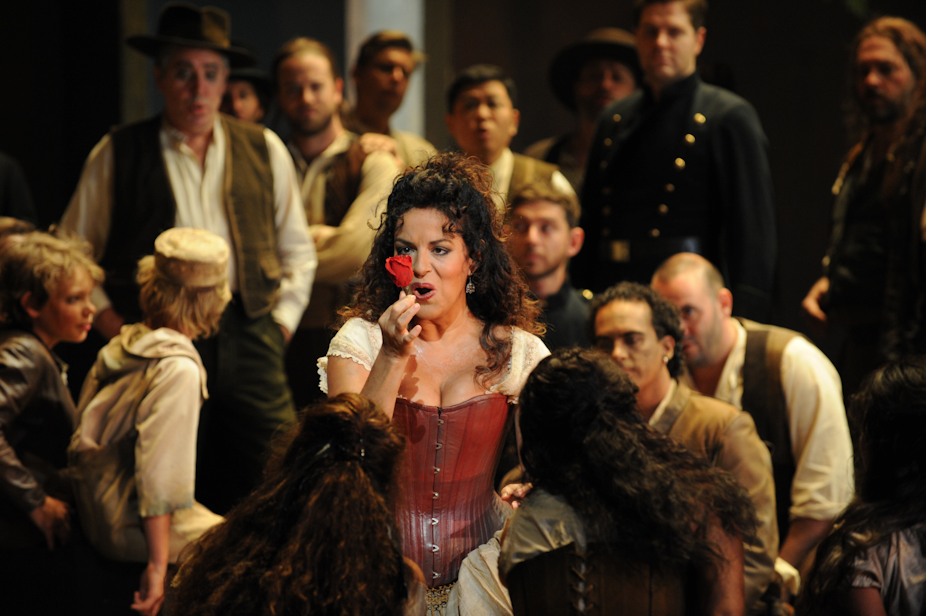The fictional character of Carmen – the heroine of Bizet’s opera – attracts a range of labels which variously position her as seductress, femme fatale, sex addict, fate/ death obsessed, victim, liberated woman and even feminist.
These descriptors have been circulating since the opera’s premiere in Paris in 1875. From its initial underwhelming success, Bizet’s Carmen has become one of the world’s most popular and frequently performed operas. Opera Australia’s production of Carmen, based on the Royal Opera House, Covent Garden and Norwegian National Opera co-production, opens in Melbourne tomorrow night.
Carmen is often simply understood as a story about a doomed love affair. But there is a little more to it than that …
A battle of the sexes
The story of Carmen has two central characters. Don José, a soldier from the country, and Carmen, an exotic gypsy woman working in a cigarette factory. Carmen has been causing trouble in the factory and, to avoid being imprisoned she seduces Don José, who has been ordered to arrest her, and escapes. He falls in love with her. She leads him astray.

She is responsible for the break-up between Don José and his fiancée, Micaëla, the antithesis of Carmen, and prompts him to leave the army to join her and her band of smugglers. But Carmen becomes bored with Don José and finds the bullfighter Escamillo to take his place. Don José then murders Carmen in a fit of jealousy.
The opera is based on the novella Carmen (1845) by Prosper Mérimée and the subject matter in the original story, which is necessarily simplified for the opera, represents a number of fantasies involving race, class and gender that were circulating in 19th-century French culture.
In the opening chapter to American musicologist Susan McClary’s book, Georges Bizet: Carmen, language professor Peter Robinson makes the point that the real battle in Carmen is between the sexes. From the very beginning the woman is marked as the enemy. The battlefield is Carmen’s body and the story raises questions about who shall own her body while describing those who are fighting over it.
Robinson suggests there are two exotic anecdotes threaded into the story. The first deals with the notion of the “uncivilised”. Accordingly, Carmen, the gypsy girl, and the nomad smugglers are portrayed as violent, disorderly, superstitious and diabolical.
The second anecdote is concerned with order, rationality and logic. These characteristics are represented by Don José. He epitomises the hallmarks of French civilisation. These elements, which compose the structure of the story, are linked to control and mastery.

Throughout the story, Carmen is associated with the colour red. Red is the life-force itself. But when it spills outside the body, it is the colour of death.
In Opera; or the Undoing of Women, French feminist writer Catherine Clément similarly attributes Carmen’s death to the oppression of women by men. Carmen must die because she refuses to acquiesce to the desires of Don José.
Carmen is sometimes seen as the female equivalent of the Don Giovanni character in Mozart’s opera of the same name. In his book, A Song of Love and Death, Australian literary scholar Peter Conrad says that both characters are impelled to remain eternally in motion, pursuing, in Don Giovanni’s case, and manoeuvring free, in Carmen’s. They can only be truly satiated in death. Carmen seeks to keep all men in the world from knowing her. She is portrayed as mysterious, unpredictable, perpetually contradictory and elusive.
It’s all in the music
The vitality of Carmen is evoked by clever musical techniques. Carmen’s music is sexy and exotic and is, as McClary writes:
grounded in pseudo gypsy dance forms that are referred to by their dance type designations: Habañera (a Cuban genre from Havana) and Seguidilla (a dance from Southern Spain, possibly of Moorish origin).
McClary’s analysis, paraphrased here, shows how music is able to powerfully conjure the essence of the characters. It also intensifies the themes of the sexual, racial, and exotic in the opera.
Carmen’s rhythms set her body in perpetual motion. They are contagious and seductive, drawing attention to her body and arousing desire. Before she begins to sing the first note of her famous Habañera, the instrumental pattern – di-da-da-daa, di-da-da-daa – is already engaging her body, setting her hips in motion.
Her melody, which begins after the short instrumental introduction, sounds as if it is slipping in-between the cracks of the notes. It is excessively chromatic – a chromatic scale ascends and descends through all the 12 semitones of the octave and is less stable than a major or minor scale which is based on 8 notes of the octave – and slippery, descending seductively by half steps. It taunts and teases. It draws attention to the erogenous zones. But the music also alternately coaxes and frustrates. It lingers on notes that have a strong gravitational urge to move onward.
In Feminine Endings, McClary writes that Carmen:
plays with our expectations not only by lingering but also by reciting in irregular triplets that strain against the beat.
This helps to create the allure of her exotic, sexy character and to portray her as proficient in the art of seduction. Carmen’s music refuses to be contained. It is used to mercilessly manipulate Don José, who is obsessed with her.
By giving Carmen unpredictable, disordered music, she is portrayed as the opposite of Don José. According to McClary, Don José’s story organises the narrative and his fate hangs in the balance between the Good Woman (his fiancée) and the Bad Woman (Carmen). His music is no less invested in the libido than Carmen’s but it is marked to contrast. Don José’s music is devoted to loftier sentiments rather than to the body. It is made to behave in accordance with the universal tongue of Western art music.
Accordingly, Don José’s famous Flower Song constructs “images of fevered longing and dread, as he imagines Carmen as demon and then as object of desire. He sings of submitting himself masochistically to her power”. There is a lyrical urgency in the song but the music behaves as if it is constrained.
Gradually, the opera leads to inevitable closure brought about by the violent murder of Carmen. The chromatic slippage of Carmen’s music, which McClary says is carefully defined throughout the opera as “feminine”, is purged once and for all.
McClary notes that unlike earlier scenes, in which Bizet has freely indulged in Carmen’s sexy music, the final scene is informed by the necessity for tonal closure.
As José pleads with Carmen to give in, the bass line presents a slippery chromatic floor. The chromaticism must be excised. At the same moment that the crowd inside the bullring cheers in response to Escamillo’s victory over the bull, we (the music lovers) witness and celebrate the victory over an even more treacherous beast.
Chromatic slippage (representing disorder and chaos) is expunged, making way for the major triad (representing order and uniformity) which prevails.
McClary says that for all the formal neatness of this conclusion, “we leave the theatre humming her infectious tunes”. The femme fatale character lives on through her music. In death, she has the ultimate control over her destiny. And thus Carmen is forever immortalised as one of the great heroines.
Opera Australia’s season of Carmen runs May 14-25 at the Arts Centre Melbourne, State Theatre.

